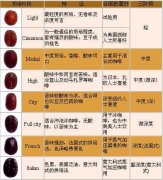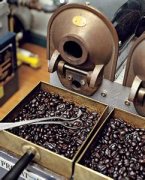Coffee Encyclopedia Coffee beans packaging and selection
1. Coffee Bean Packaging
Oxygen-containing packaging: can block light, but because there is residual air in the packaging, it cannot prevent the oxidation of coffee;
Vacuum packaging: vacuum plastic packaging
Vacuum can packaging
It can prevent coffee oxidation very well
Gas filling packaging: filling inert gas into the package and replacing air
One-way valve packaging: the use of special valve function will be generated in the packaging of carbonic acid gas to the outside, and do not make the outside air poured in;
How to choose coffee beans
How should we judge the freshness of coffee beans?
First, you should clearly indicate the roasting date of the product (you should buy products with roasting date within one week, do not trust the shelf life indicated on the coffee packaging bag). Buy from coffee roasters with brand reputation and emphasis on fresh roasting, and avoid buying coffee beans without roasting date and unclear freshness.
Second, good coffee bags usually have a "one-way vent valve"(a button-like hole in the top of the coffee bag) designed to allow the coffee beans to vent naturally occurring carbon dioxide. The one-way exhaust valve at the nose, gently squeeze the coffee bean bag, smell the squeezed gas taste, if it is a charming aroma of coffee, freshness is not a problem, on the contrary, if it smells not strong enough, or even with the smell of smelly oil, it means that this packet of coffee has long deteriorated and should be avoided.
Thirdly,"Freshly baked light baked beans should be dry and oil-free on the surface, and freshly baked dark baked beans should be oily on the surface" is a correct concept that we should understand. When buying coffee beans, the appearance of oil, no oil is a reference index to judge freshness, but not absolute. It is best to buy fresh roasted coffee beans with good reputation and marked roasting date.
When purchasing, grab one or two coffee beans in the mouth to chew, if the crisp sound (indicating that the coffee beans are not wet), the teeth cheek fragrance is the top grade, but it is best to pinch with your hand, feel whether it is solid, rather than buy empty coffee. Freshly fried coffee beans are not suitable for immediate drinking and should be stored for a week in order to completely release the gases in the beans. Generally speaking, the best drinking period of coffee is one week after frying, when the coffee is the freshest and the aroma (Aroma) tastes the best.
Oily coffee beans and freshness
There are two reasons for "oil beans". a) stale light baked beans b) fresh dark baked beans
A) not fresh light roasted beans roasted light, the appearance of a light brown color "light roasted beans", after roasting, the appearance of dry, and will not oil, about six days out of the oven began to appear "dot oil" phenomenon (a certain side of the coffee beans appear dot oil droplets), slight "dot oil" does not mean that not fresh, sometimes the light roasted coffee beans flavor in the peak state. Continue to place, more than two weeks after baking, the surface of the light baked beans gradually a layer of bright oil, at this time "light baked beans" flavor has begun to decline, should avoid buying.
b) Fresh deep-baked beans The deep-baked beans with dark brown color appear slightly oily after baking, and a large amount of "oil" begins to appear on the surface from the second day to the fifth day. Deep baked beans with shiny appearance do not mean that they are not fresh. On the contrary, deep baked beans will gradually dry out after three weeks, and finally become dry and stale beans. Therefore, if you see coffee beans that are dry and not oily, but appear dark brown in appearance, please pay special attention to whether they indicate the roasting date, which is most likely to be stale beans that have deteriorated.
Even if it is already stale, the appearance of "light baked beans" will gradually dry after a long time (such as three months), and finally return to a dry and oily appearance. It can be seen that whether the appearance of oil is only a reference to judge the freshness of coffee beans, not absolute.
Instant coffee is made from Robusta coffee beans. Strong taste, high caffeine content
How to make instant coffee:
1. Spray drying method
2. Freeze drying method
3. Sintering method
Instant coffee 10%, creamer 60%, sugar 30%, and added aroma and so on.
Coffee with less than 0.5% caffeine
Coffee with less than 0.1% caffeine
Important Notice :
前街咖啡 FrontStreet Coffee has moved to new addredd:
FrontStreet Coffee Address: 315,Donghua East Road,GuangZhou
Tel:020 38364473
- Prev

The purpose and method of roasting coffee.
The purpose of roasting: 1, aroma 2, increase the complexity of coffee 3, obtain color 4, form the unique aroma of coffee roasted coffee beans this method seems to flow after the 13th century, until then it has been made with raw coffee beans soup to drink. At present, there are three methods for roasting coffee beans: direct roasting, making coffee taste and aroma.
- Next

Introduction of coffee utensils roaster
The roaster is mainly divided into four types: direct fire type, semi-hot air direct fire type, hot air type and electric type. 1. Direct fire is the earliest baking tool, that is, the raw beans are roasted by fire and then transferred to the drum. The built-in motor keeps running the drum and stirring the coffee beans in the drum, trying to make each coffee bean come into contact with the hot iron evenly to achieve the goal of balanced roasting.
Related
- Beginners will see the "Coffee pull flower" guide!
- What is the difference between ice blog purified milk and ordinary milk coffee?
- Why is the Philippines the largest producer of crops in Liberia?
- For coffee extraction, should the fine powder be retained?
- How does extracted espresso fill pressed powder? How much strength does it take to press the powder?
- How to make jasmine cold extract coffee? Is the jasmine + latte good?
- Will this little toy really make the coffee taste better? How does Lily Drip affect coffee extraction?
- Will the action of slapping the filter cup also affect coffee extraction?
- What's the difference between powder-to-water ratio and powder-to-liquid ratio?
- What is the Ethiopian local species? What does it have to do with Heirloom native species?

